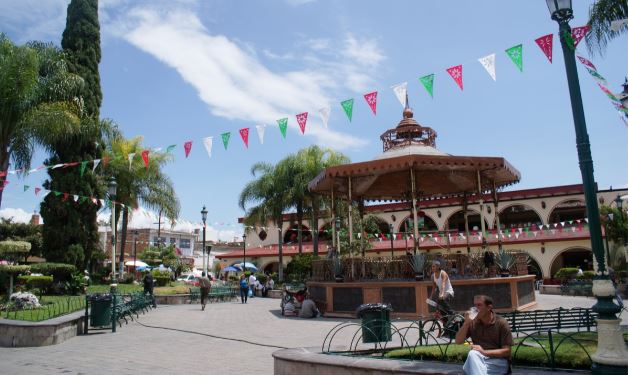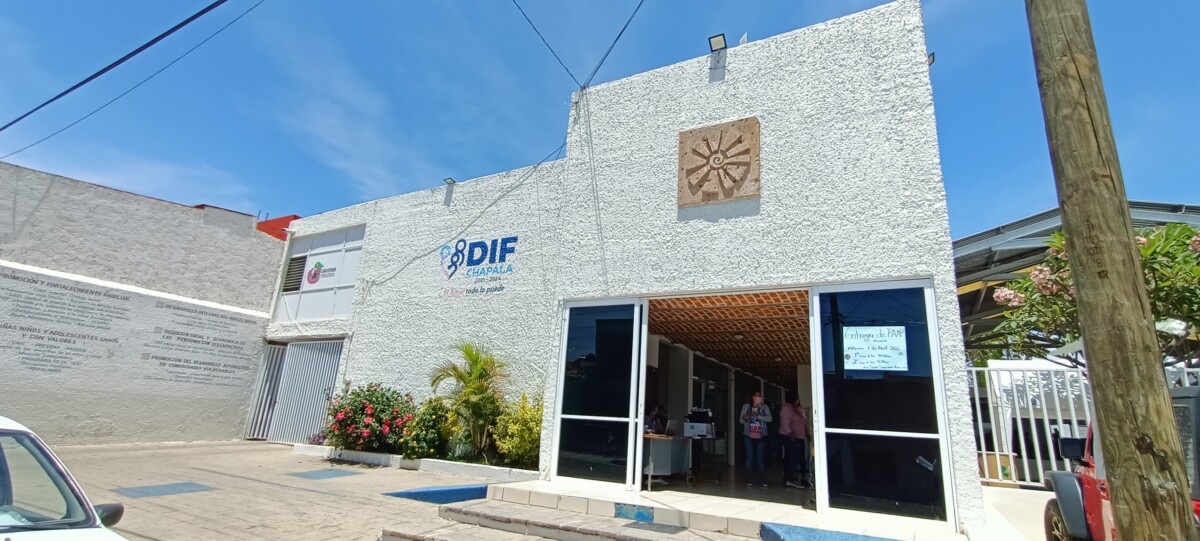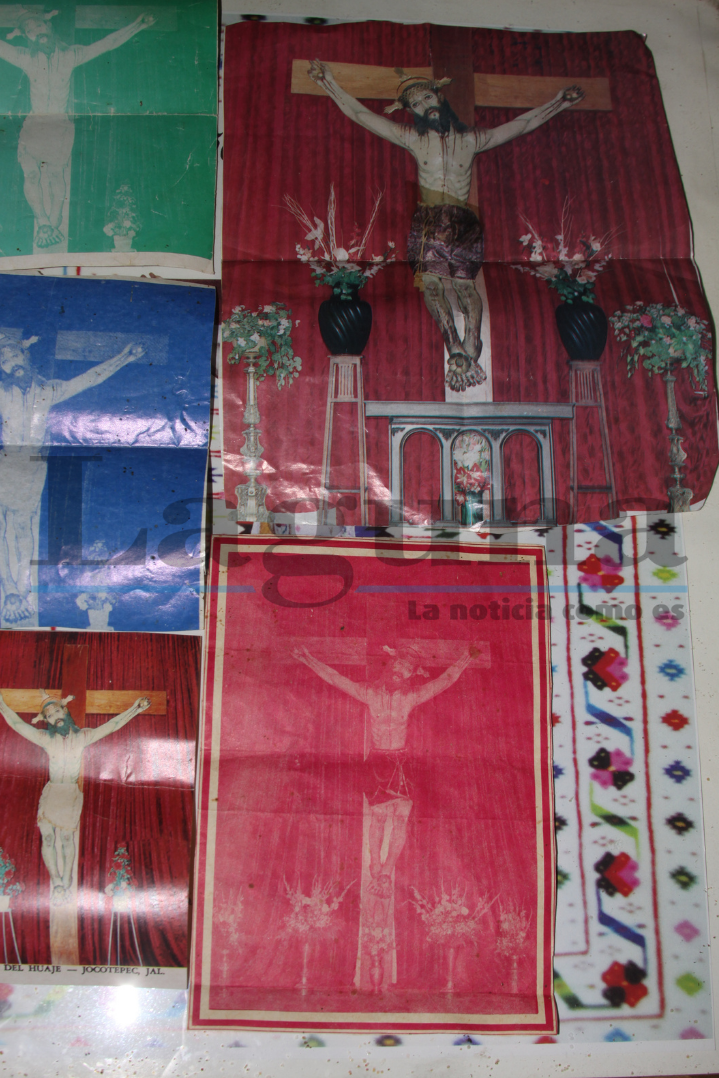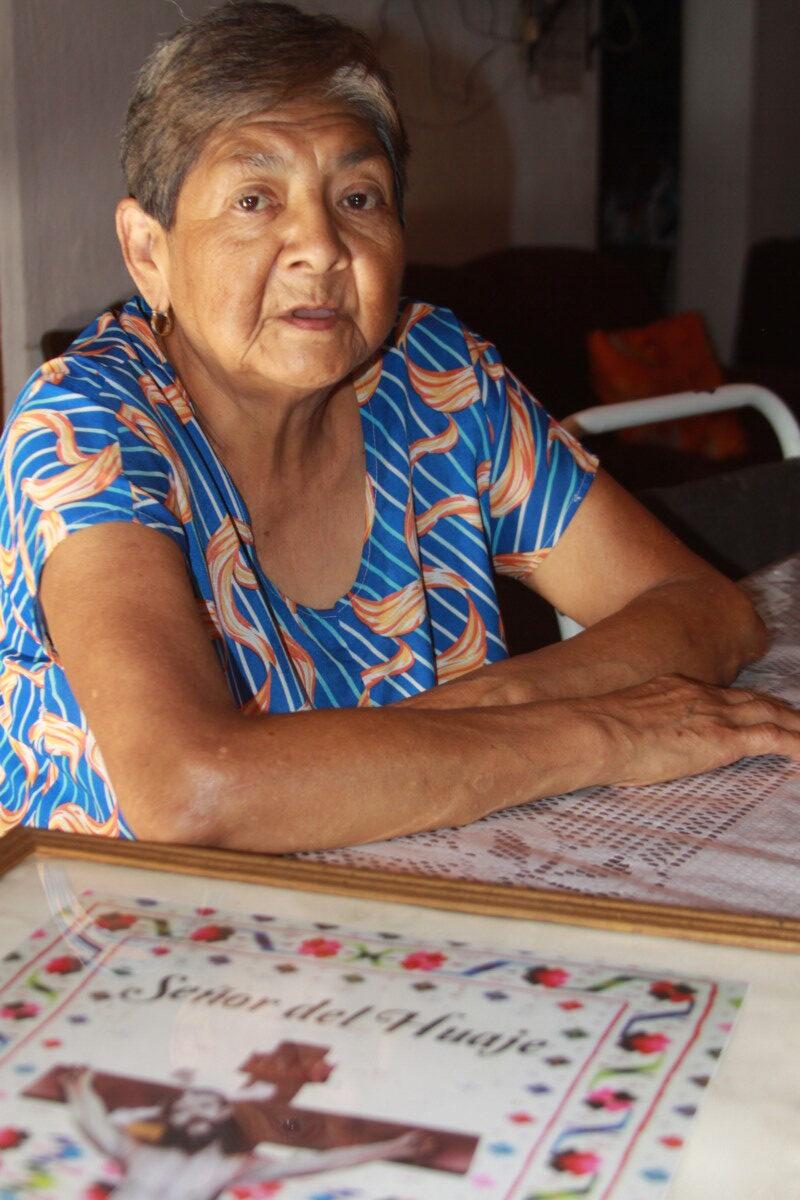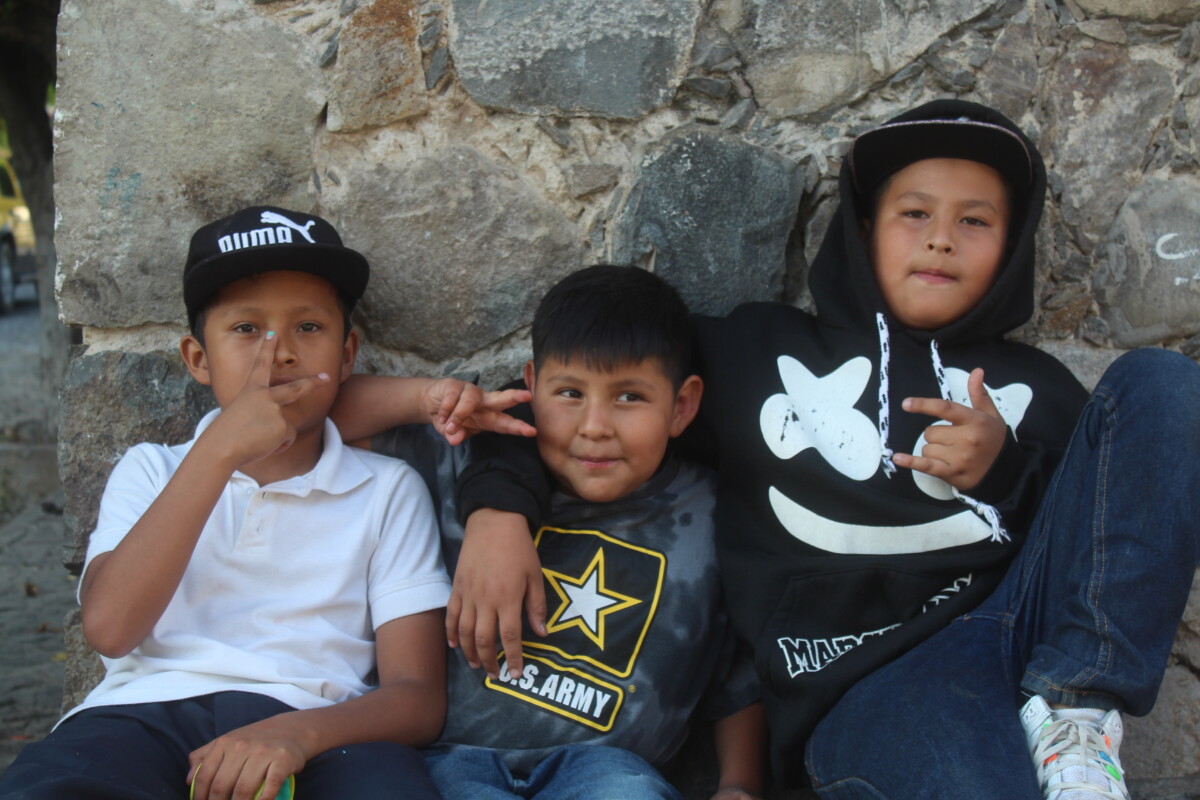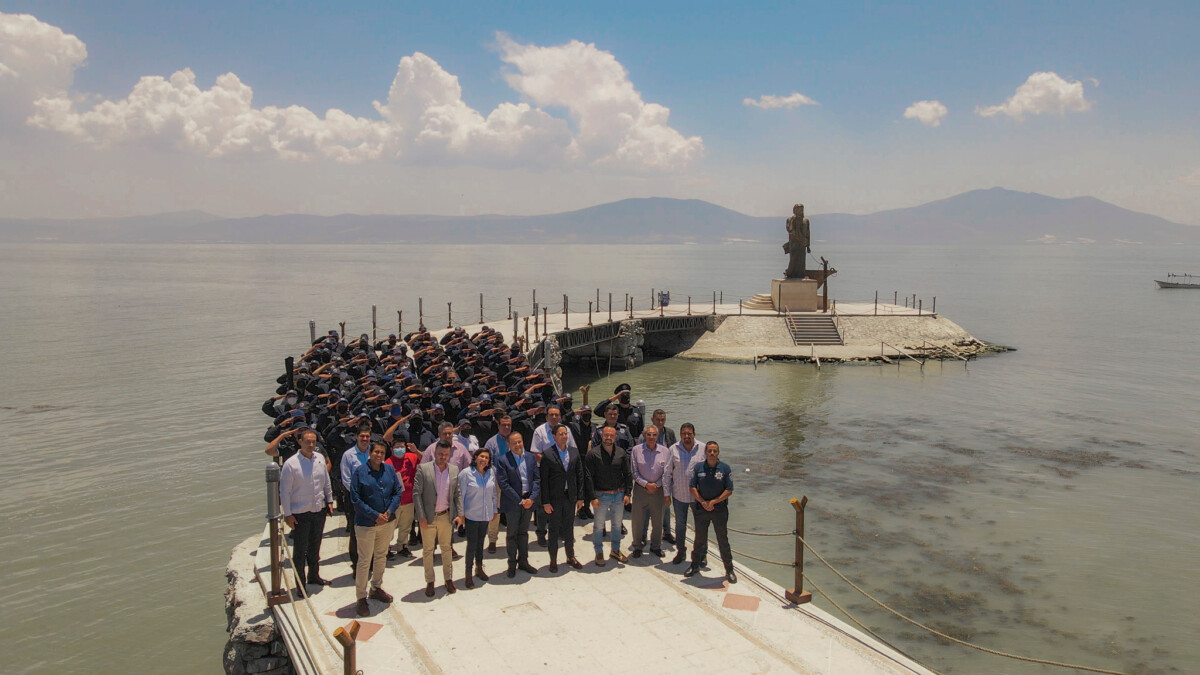gente
Destaca Chapala en recuperación de empleos durante abril; Jocotepec en pérdida
Chapala generó 76 nuevas plazas formales durante abril, según el IIEG. Foto: Archivo.
Redacción.- Durante el mes de abril pasado, Chapala se colocó en la lista de los 20 municipios con mayor generación de empleos; mientras que Jocotepec se integró a los de mayor pérdida.
Esto de acuerdo a las cifras presentadas por el Instituto de Información Estadísticas y Geográfica del estado (IIEG), sustentadas en la base de datos del IMSS de los trabajadores asegurados.
Chapala ocupó la posición número 13 con 76 nuevos empleos formales generados durante abril, 59 de ellos permanentes y 17 eventuales; esta categoría fue liderada por Autlán de Navarro con 514 trabajadores, Tonalá con 454 nuevos empleos y Guadalajara con 401 asegurados más.
En contraste, Jocotepec se posicionó en el sexto lugar de la lista de los municipios que mayor pérdida registraron con 271 empleos formales menos, 167 eventuales y 104 permanentes; Zacoalco de Torres fue el que mayor pérdida tuvo con -925 trabajadores, seguido de Tlaquepaque con -835 y Zapotlán el Grande con -741 empleos formales.
A nivel estatall, Jalisco perdió 2 mil 61 plazas formales durante abril de 2022, principalmente del sector de la agricultura, ganadería, silvicultura y pesca. Pese a esta caída, durante el primer cuatrimestre el estado generó 34,716 empleos nuevos, colocándose como la segunda entidad en el país con la cifra más alta en generación de empleo formal en el acumulado anual.
Detienen a dos hombres en Chapala por robo a iglesia
El robo se efectuó en la parroquia de San Francisco de Asis. Foto: Archivo.
Redacción.- Dos hombres fueron detenidos por presuntamente robar más de 6 mil pesos en una iglesia de Chapala.
Personal de la Fiscalía Regional puso a disposición de los jueces que los requerían con una orden de aprehensión por el delito de robo calificado.
Se trata de Yahir Alejandro G. y Víctor Alfonso C., quienes fueron detenidos en la calle Isla del Presidio al cruce con De los Maestros, de la colonia Gastronómica, en el municipio de Chapala.
Los hechos por los que fueron capturados ocurrieron la semana pasada y, de acuerdo con las indagatorias estas personas ingresaron a la iglesia de San Francisco de Asís, forzaron un lucernario de monedas que se encontraba a pie de una imagen católica y extrajeron la cantidad de 6 mil pesos, motivo por el cual les resultó la orden de aprehensión.
Ambos fueron puestos a disposición del Juez de Control y Juicio Oral del Quinto Distrito Judicial, quien resolverá su situación jurídica. Las personas detenidas serán tratadas como inocentes en tanto no se emita una sentencia en su contra.
Se gradúan diez elementos de la Policía de Chapala de la generación undécima del curso inicial para policías
Durante la ceremonia se entregaron 95 Certificados Únicos Policiales por parte de Autoridades municipales de las regiones 4 y 12 de Jalisco además de la Diputada por el distrito electoral 17 y representantes del estado de Jalisco.
Redacción. – Diez elementos de la Comisaría de Chapala se graduaron y certificaron en el 11° Curso de Formación Inicial para Policía Preventivo Municipal Modalidad Equivalente, frente a las letras monumentales al ingreso de la estatua de Jesús Pescador.
Con ello ahora el municipio cuenta con 54 policías certificados de los 103 que cuenta la corporación, quienes se hacen cargo de guardar por la seguridad y tranquilidad de un municipio que alcanza los 55 mil habitantes.
Durante la ceremonia en la que se entregaron 95 Certificados Únicos Policiales a elementos de la región 4 Ciénega y la región 12 del Centro del estado, el alcalde de Chapala, Alejandro de Jesús Aguirre Curiel, se planteó como meta que la totalidad de los elementos del municipio sean certificados.
“En Chapala reconocemos siempre el trabajo que realizan las y los elementos para tener espacios seguros, libres de violencia”, externó el alcalde anfitrión de la ceremonia, a la vez que, reconoció el trabajo de los elementos graduados a quienes recordó que el primer deber de las corporaciones policiales es servir y mejorar la seguridad de las y los ciudadanos.
El alcalde de El Salto, Ricardo Said Santillán Cortés, en representación de los municipios beneficiados externó que, con la desaparición de recursos federales en materia de seguridad, las municipalidades se vieron en graves problemas y que, sobre las obras, lo que la gente demanda es la seguridad, destacando el apoyo del Gobierno de Jalisco para capacitar y equipar a las policías municipales.
Durante la ceremonia también se entregaron 64 constancias del Curso de Formación Inicial para Policía Preventivo Municipal Modalidad Equivalente a los elementos de las dos zonas de Jalisco.
El Coordinador Estratégico de Seguridad del Estado de Jalisco, Ricardo Sánchez Beruben, compartió que, a partir de algunos años, ser policía ha sido referente para las siguientes generaciones reconociendo que detrás de cada uniforme hay historias y sacrificio que hacen de Jalisco un lugar más seguro.
Desde el 2016 es una obligatoriedad el Certificado Único Policial por lo que desde que inició la administración del gobernador Enrique Alfaro Ramírez se instalaron los Consejos Regionales de Seguridad para saber las necesidades y carencias de los municipios.
Es así que, se implementó la Estrategia de Capacitación Itinerante para la obtención del Certificado Policial que ha llegado a su novena generación y cuenta con cinco sedes regionales y una central, beneficiando a dos mil 461 policías de 116 municipios en un transcurso de dos años.
Chapala children awaiting adoption
The DIF building, located on Degollado Street in Chapala. (Photo: Jazmín Stengel)
Jazmín Stengel (Chapala).- The Office for the Protection of Children and Adolescents (DIF) Chapala has custody of 39 minors, but none can be adopted until DIF obtains processes of parental authority–a relative’s legal permission, a necessary requirement for adoption.
DIF initiated nine processes of parental authority last year. According to DIF, five of the 43 children in their 12 Chapala shelters have been handed over to close relatives.
In Mexico, if these processes are not initiated by the custodial authorities, either through ignorance or unwillingness, the children are at risk of remaining in shelters without the possibility of access to a family, said Paloma Ventura Valenzuela, head of the children’s ombudsman at the municipal level.
For the minors who have not undergone the process granting parental rights to access adoption, the procedures are more complicated, because in most cases the child’s relatives are untraceable or their sociolegal situation does not allow them to give up the parental rights of the child, which complicates the process for the authorities to acquire it legally, said Ventura Valenzuela.
Consequently, the children’s files remain open for years in the Public Ministry with the investigation incomplete. Additionally, many governmental administrations overlook the children’s situation, failing also to provide the social-work services to support the investigations. Some have not received reports in more than 12 years, said Emmanuel Anthony Frutos, operating director of the children’s shelter Love in Action of Chapala.
Translated by Mags Petela
Photo shoot captures artistic talents of San Juan Cosalá children
Boys and girls playing their instruments. Credit: Courtesy.
Alma Serrano (San Juan Cosalá).- The photography group known as «Social Art,» commemorated Children’s Day with a photo session on the boardwalk of San Juan Cosalá. About 20 children participated, members of Colores Que Dan Vida, and the School of Music, were photographed on April 19th.
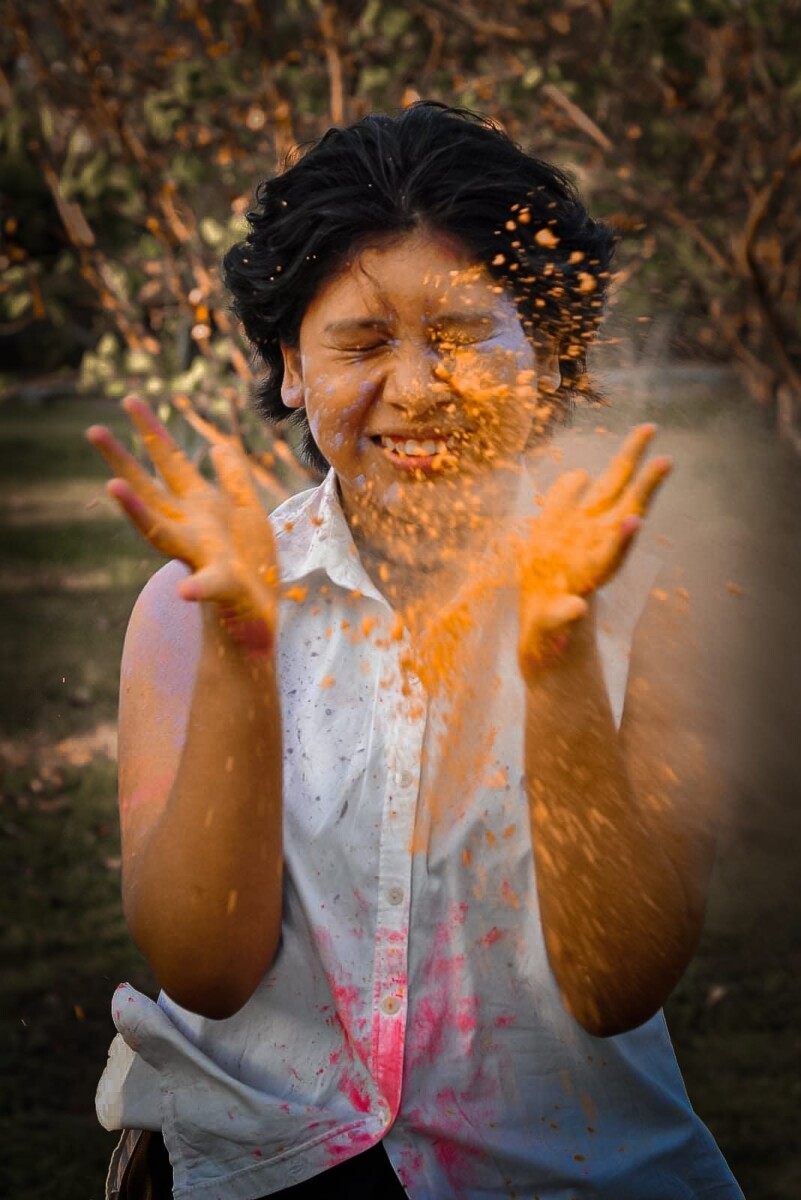
A child plays with orange pigment powder. Credit: Courtesy.
Josué Mondragón Rentería, a representative of the group of ten photographers, says that this initiative arose with the purpose of celebrating the children of the delegation in a dynamic and fun way. It was important to show the dedication and contribution of the children to the cultural development of their community, He added, «time spent in the arts and culture can change and improve the quality of life of children.»
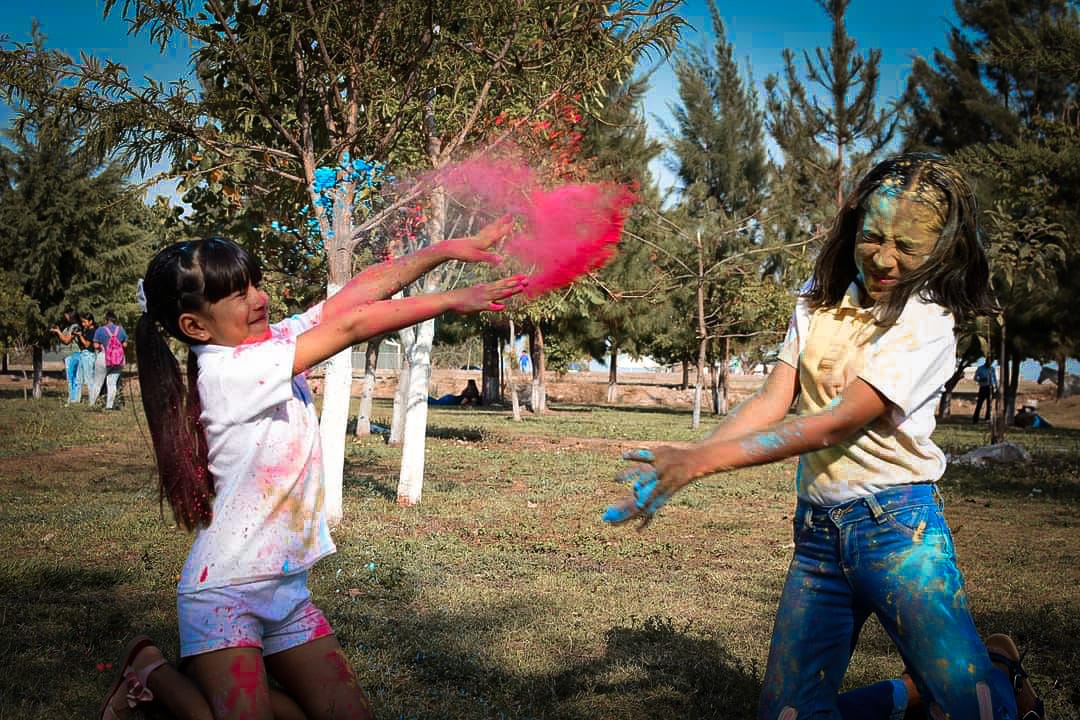
Two children, covered in pigment-stained clothes, throw pigment powder toward each other, in the spirit of fun and creativity. Credit: Courtesy.
The children were photographed playing music, and being creative in what they love to do. More than a commemoration, they were free to play and experiment on the theme of “the meaning of art.”
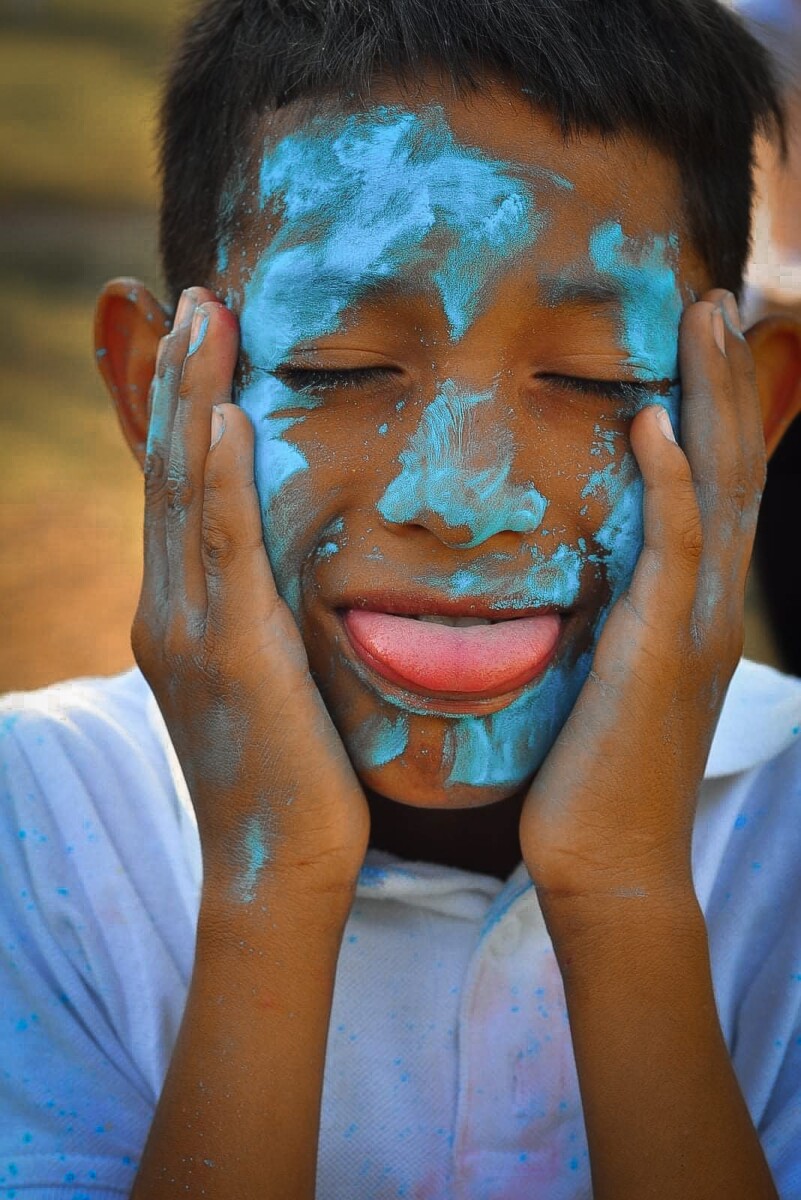
A young child enjoying their face, covered in blue paint. Credit: Courtesy.
Los milagros del Señor del Huaje
Bertha Mendoza Díaz profesa un gran fervor a la imagen del Señor del Huaje.
Fotos y texto por: María del Refugio Reynozo Medina:
Sus padres les enseñaron que Dios existe; no con palabras, sino con amor. Bertha Mendoza Díaz tiene 73 años y es originaria de Jocotepec; ella y su hermano Cándido Mendoza Díaz crecieron viendo la amorosa devoción al Señor de Huaje por parte de sus padres.
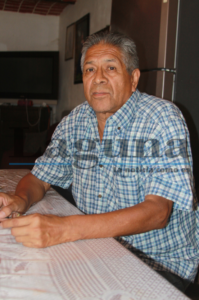
Cándido Mendoza Díaz es obrajero, músico, maestro de arte de preparatoria y profesa un amor por el Señor del Huaje inculcado por sus padres.
Su padre, Cirilo Mendoza Valencia, uno de los obrajeros de Jocotepec, enseñó el oficio a Cándido quien además de obrajero es músico y ha sido maestro de artes de Preparatoria por 24 años.
Cirilo Mendoza siempre quiso ser parte de los organizadores de la fiesta del Señor del Huaje. Le profesaba una gran devoción, pero no era integrante de ningún grupo.
Hasta sus oídos llegó la noticia de que era el último año que se celebraba al Cristo por falta de recursos económicos. Era por el año de 1970. Don Cirilo pidió participar, y para ello sólo tuvo que acudir a la parroquia del Señor del Monte para pedir unas cortinas y candelabros prestados pues el recinto del Señor del Huaje no tenía.
Don Cirilo acudió con el señor cura para pedirle en préstamo lo necesario.
El señor cura le dijo:
-Si alguna de las cosas se pierden, las pagarás.
-Si es necesario quedarme con él a dormir me quedo, le contestó.
La noche de la víspera de la fiesta, el grupo de ayudantes se dispuso a cerrar la puerta una vez terminado el adorno; la puerta permaneció inmóvil no podía cerrarse ni siquiera con la ayuda de los demás.
Entonces recordó que había prometido quedarse a dormir con él.
Los organizadores solidarios se unieron a don Cirilo y fueron por sus artículos personales para pasar la noche en vela. Algunos de ellos eran Ángel Paz, Benito Inés y Catarino Olmedo.
Cuando estuvieron de regreso y ya se disponían a acomodarse, intentaron cerrar el pesado portón de madera. Ante la mirada de todos, el portón cerró. Entonces volvieron a sus casas.
-Nos estaba tanteando- dijo uno.
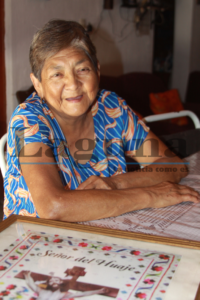
Bertha Mendoza Díaz conversa sobre los testimonios de fe.
Las primeras celebraciones en honor a este Cristo eran sólo de dos días: sábado y domingo; en los días posteriores a la fiesta de enero. Luego se concretó la celebración de un novenario.
La señora Bertha continuó con el amor hacia la imagen y estuvo muy cercana a las actividades del templo.
Aunque en el templo no siempre se vivió la contemplación amorosa; recuerda a un señor cura Emeterio Romo se llamaba, para la señora Bertha y otros vecinos, siempre fue muy extraño su actuar.
Decía que por qué hacían tanta fiesta, le daban alergia las flores.
Cuando le solicitaban autorización para la fiesta, se portaba renuente.
-Son nuestros cristos aparecidos- le decían las mujeres.
-Cristos aparecidos, monos de palo- arremetía el cura.
En una ocasión por el año del 75 Bertha se enteró que se llevaba a cabo una junta para cambiar la fecha de la fiesta, ella junto con más personas no estaba de acuerdo y trataron de impedirlo. Al final cambiaron a la actual fecha de mayo, pero en enero de ese año también lo celebraron.
La última, fue la fiesta de los excomulgados les decían a quienes participaron en ella. La primera vez que celebraron la fiesta en mayo, los organizadores mandaron citar a los organizadores de la de enero, a través de la presidencia para que les prestaran la plataforma. Los ánimos se crisparon y unos y otros estaban en pugna por la mentada plataforma.
Al final se las prestaron y ese año el Señor del Huaje tuvo dos fiestas y muchos fieles que se congregaron en torno a la imagen.
Se dicen muchas cosas de ese Cristo, alguien dijo una vez que entreabrió los labios. Algunos dicen que a veces se hace muy pesado. O que no siempre, las fotos que les son tomadas salen.
Contaban también que un hombre le prometió unas cortinas, y como no las compraba, una tarde llegó un señor a su casa llevando unas cortinas.
-Aquí encargaron unas cortinas- dijo.
Y solicitó el pago.
-No te hagas el chocante – alguna vez le dijo una mujer con cariño.
La señora Bertha profesa un gran amor por este crucificado y conversa de cerca con él. En una ocasión, a su nieta le robaron una camioneta. “¿Por qué?”, pensó y cuestionó para sus adentros; “era la camioneta o ustedes”, escuchó en el fondo de su corazón.
En una ocasión, pensó que todo había terminado, le diagnosticaron un tumor, la intervención era urgente, y antes de partir para el hospital, Bertha se arrojó a los pies del crucificado suplicando por su salud, cuando estaba en el hospital sometida a los exámenes clínicos, los médicos no encontraron nada maligno. En su corazón comprendió que fue él.
¿Qué si lo quiero?
Me dice con una mirada lejana.
¡Ay que si no lo quiero! dice con una franca sonrisa, muy cerca del llanto.
-Yo no sólo he escuchado de él, desde el vientre de mi madre lo he vivido y amado.
Lakeside Chronicles
Bertha Mendoza Díaz professes great fervor to the image of the Lord of Huaje
María del Refugio Reynozo Medina.- Seventy-three-year-old Bertha Mendoza Díaz is originally from Jocotepec. She and her brother Cándido Mendoza Díaz grew up seeing the loving devotion to the Lord of Huaje by their parents. The Lord of Huaje is one of the two sacred images of Christ revered in Jocotopec. The other is the Lord of the Mountain.
Their father, Cirilo Mendoza Valencia, one of Jocotepec’s artisan woodworkers taught the trade to Cándido. Cándido, in addition to being a woodworker, is a musician and has been a high school art teacher for 24 years.

Bertha Mendoza Díaz talks about the testimonies of faith.
Because of his great devotion, Cirilo Mendoza always wanted to be one of the organizers of the feast of the Lord of Huaje. Around 1970 he heard that it would be the last year that the Lord of Huaje would be celebrated due to lack of economic resources.
Don Cirilo went to the parish of Señor del Monte (Lord of the Mountain) to ask to borrow some banners and candlesticks because the precinct of the Lord of Huaje did not have any.
Don Cirilo asked the priest permission to borrow what he needed. The priest told him, “If any of the things are lost, you will pay for them. Don Cirilo replied, “If it is necessary for me to stay and sleep with him, I will.»
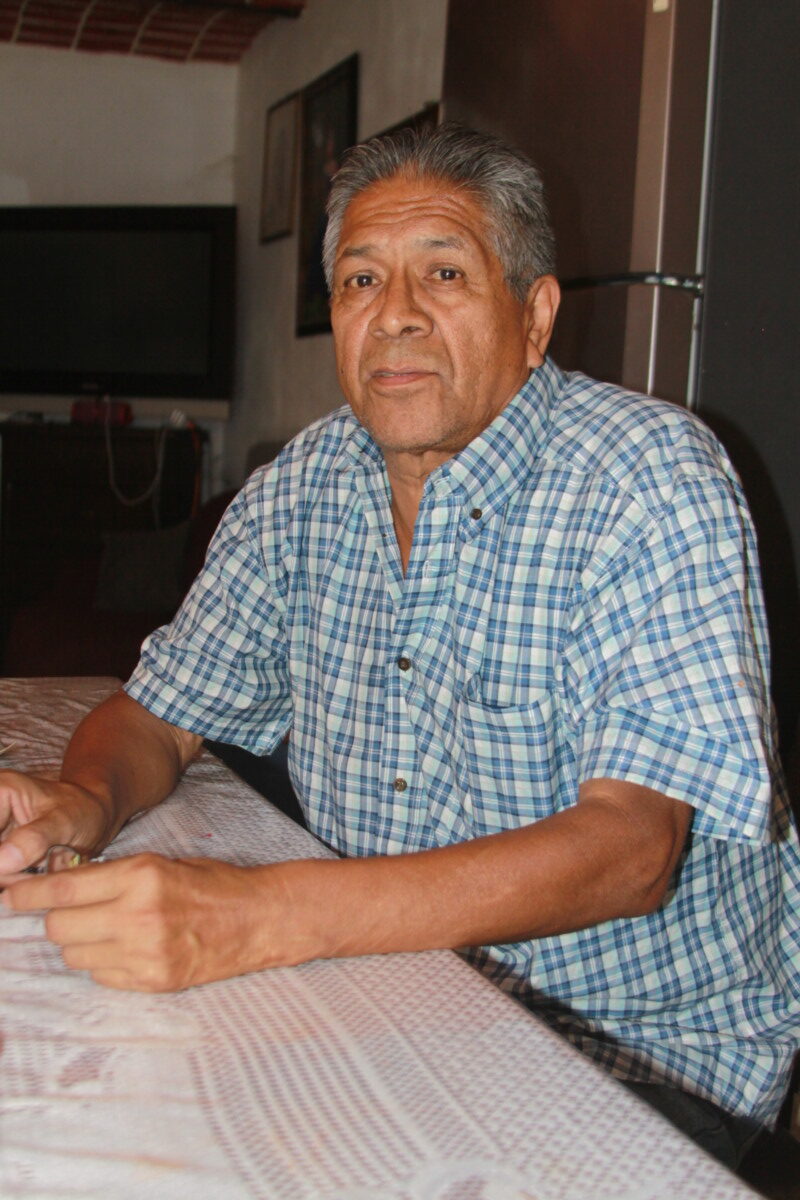
Cándido Mendoza Díaz is a laborer, musician, high school art teacher and professes a love for the Lord of Huaje instilled by his parents.
On the evening of the eve of the feast, a group of helpers set out to close the door when the decorating was finished. The door remained stuck open and could not be closed, even with the help of the others. Don Cirilo remembered that he had promised to stay overnight with the Lord. His sympathetic helpers, Ángel Paz, Benito Inés and Catarino Olmedo went to get their personal items to join Don Cirilo for a sleepless night. When they returned, ready to settle in, they tried to close the heavy wooden gate one more time. Before everyone’s eyes, the gate closed. “He was testing us,» said one of the helpers.
The first celebrations that honored this Christ were only two days: Saturday and Sunday occurring the days after the January feast. Then the celebration of a novena (nine-day prayers and celebration) was added.
Mrs. Bertha continued with her love for the image of Lord Huaje and was very close to the activities of the temple. Although in the temple a loving contemplation was not always experienced. She remembers a priest named Emeterio Romo, whose actions were very strange. He was allergic to flowers. He used to say, why are you having so many parties?” When he was asked to authorize a party, he was reluctant.
“They are our images of Christ,» the women would tell him.
On one occasion in 1975 Bertha found out that a meeting was being held to change the date of the feast. She and other people did not agree and tried to prevent it. In the end, the celebration date was changed to the current one in May. But the first year of the change they celebrated in January and May.
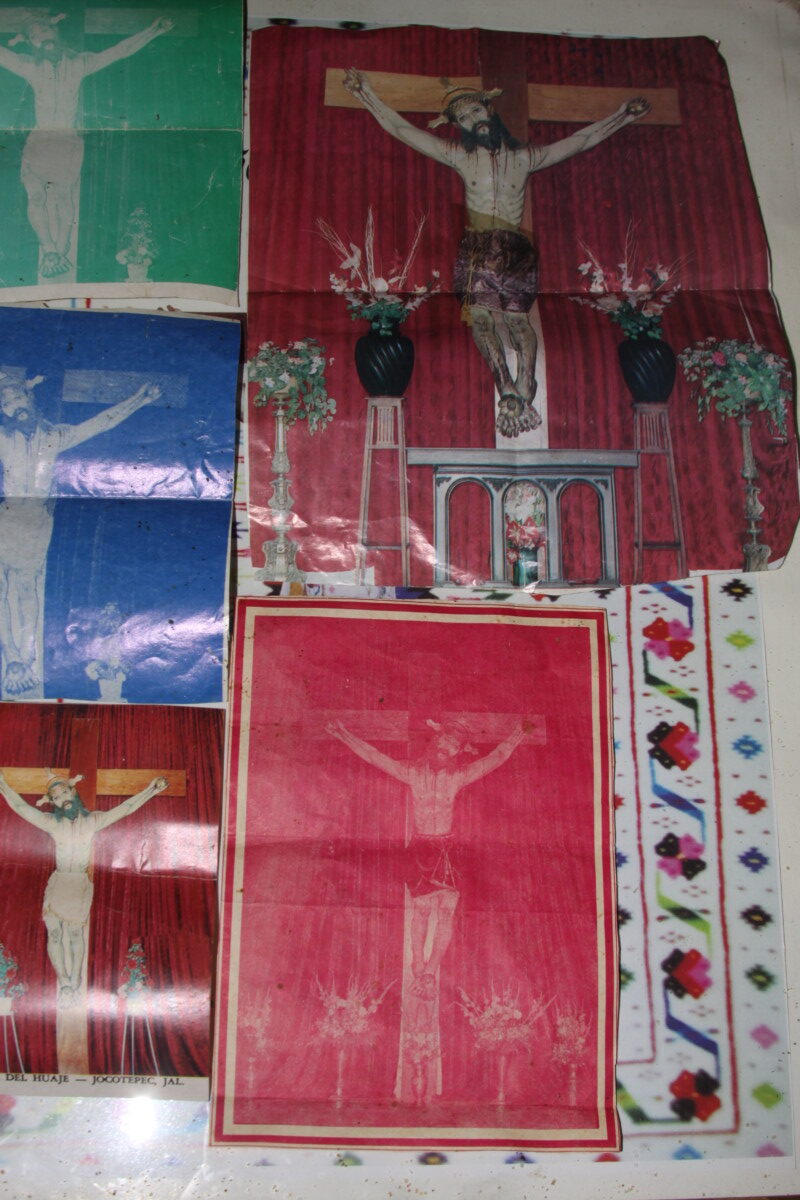
Mrs. Bertha jealously guards all the images of the Lord of Huaje that come into her hands
That last January celebration has been referred to as the feast of the excommunicated, referring to the people who participated in it. The first time the celebration was held in May, the organizers sent a summons to the organizers of the January celebration, through the presidency, so that they could borrow the platform. Tempers flared and the two groups were fighting for the platform. The platform was shared and that year the Lord of Huaje had two celebrations and many faithful gathered around the image.
Many stories are shared about this Christ figure. Someone once said that he opened his lips. Some say that sometimes it becomes very heavy to carry him. Or that sometimes the photos taken of him do not come out.
One time a man promised some banners, but he did not pay for them. One afternoon someone came to the man’s house carrying some banners. “Here are the ordered banners,» he said, and he asked for payment.
Mrs. Bertha professes great love for this crucified man and talks closely with him. On one occasion, her granddaughter had a pickup truck stolen. «Why?» she thought and questioned inwardly; «it was the truck or you,» she heard in her heart.
On one occasion, she thought it was all over, she was diagnosed with a tumor, and the need for intervention was urgent. Before leaving for the hospital, Bertha threw herself at the feet of the crucified one begging for her health. When she was in the hospital undergoing clinical examinations, the doctors found nothing malignant. In her heart, she understood that it was Him. “Do I love Him?” she says to me.
“Do I want it?” she says with a faraway look. “Oh, what if I don’t love him!” she says with a frank smile, very close to tears. “I have not only heard about him since I was in my mother’s womb. I have lived and loved him.”
Translated by Nita Rudy
Tras hechos violentos en Mazamitla, Policía Estatal mantiene patrullajes en la región Sureste
La Policía del Estado realiza recorridos de vigilancia por los municipios de la zona. Foto: SSJ.
Redacción.- Oficiales de la Secretaría de Seguridad del Estado de Jalisco (SSE) mantienen patrullajes y recorridos de vigilancia permanentes en los municipios que comprenden la región Sureste de Jalisco, como parte del refuerzo de la vigilancia y con el objetivo de brindar seguridad y tranquilidad a las y los habitantes.
La SSE informó que los policías, además de patrullar, realizan acciones de proximidad con la ciudadanía en los municipios de Concepción de Buenos Aires, Manzanilla de la Paz, Mazamitla, Valle de Juárez, Quitupan, Tuxcueca y Tizapán el Alto.
La presencia de la Policía del Estado se da como parte de las acciones de refuerzo a la vigilancia en esta zona, así como en coordinación con las autoridades locales, la Guardia Nacional y la Secretaría de la Defensa Nacional para propiciar entornos seguros tanto para los habitantes como para quienes realizan actividades turísticas.
Este refuerzo en la seguridad se da tras los hechos violentos que dejaron tres personas sin vida y diversos bloqueos carreteros, luego de un enfrentamiento armado acontecido el domingo primero de mayo en el municipio de Mazamitla.
Rap kids from Ajijic embark on their musical careers
From left to right: Diego Zamora «Dj Azteca», Jorge Ramón Rochin «Dj George» and Cristian Axel Rochin «Dj Kid». Photo: Sofía Medeles.
Sofía Medeles (Ajijic).- Ajijic has a reputation for being a center of artists, not only in painting, but also in music. Currently, the rap music genre has influenced it’s new generations, demonstrated by Diego Zamora, 11 years old, Cristian Axel Rochin, 12, and Jorge Ramón Rochin, 9, three children who decided to start their career as rappers. Their artistic names are: Dj Kid, Dj Azteca and Dj George and they acquired a taste for rap and an intention to perform it from an early age.
It was not until recently that they put it into practice, attending the Cochera Cultural art center in Ajijic where different workshops are taught for children in the San Sebastian neighborhood, north of the town of Ajijic. «We are the only ones who rap in the garage. (Cochera Cultural). Our favorites are Santa Fe Klan and Gera MX – they inspire us», they told Laguna.
Their first performance in front of an audience was last Friday, April 22, as part of the Earth Day commemoration program, in the main square of Ajijic. The three children had a space to share their rhymes, which were applauded by the audience.
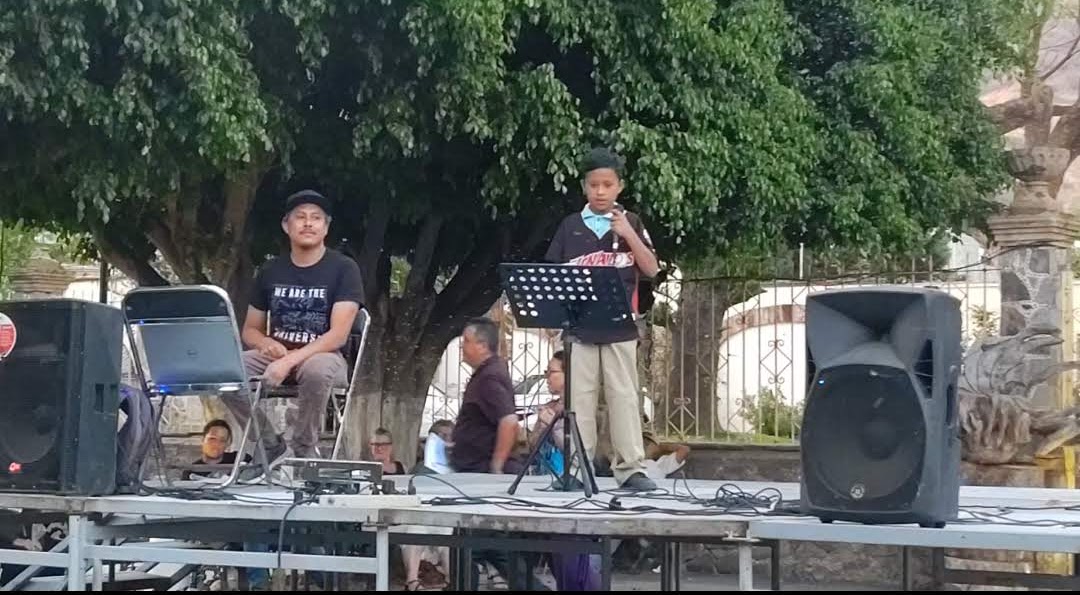
Dj Azteca during the presentation last Friday, April 22.
«We were nervous, but once we finished we felt calm. Our teacher told us to put all our energy into the presentation. We don’t know when we will perform again with an audience like this, but this last time made us feel more encouraged,» shared Dj Kid.
The three kids, who say they are in the process of recording an album at the Cochera Cultural, said they would also like to publish their songs on video platforms such as YouTube. They also advised their contemporaries to continue with their goals, and to get support from teachers to increase their skills.
The artist from Ajijic and teacher of some of the workshops for children at the Cochera Cultural, Artistic Director Antonio López Vega, commented that the project is aimed at children from the San Sebastián neighborhood and its surroundings, with workshops on children’s painting, papier-mâché, ceramics, among others, as well as the music workshop taught by Eleazar Soto and the dance workshop with teacher Emilia Gálvez.
These workshops are held on Saturdays from 10:00 a.m. to 12:00 noon and are free of charge. Antonio Lopez said that the program is happy to accept donations in kind for the children, for example, paper for painting, brushes of different sizes, etcetera.
Translated by Patrick O’Heffernan
Ten members of the Chapala Police Force graduate from the eleventh Course of the initial course for police officers.
During the ceremony, 95 Single Police Certificates were handed over by municipal authorities from regions 4 and 12 of Jalisco, as well as the Deputy for electoral district 17 and representatives of the state of Jalisco.
Editor.- Ten officers of the Chapala Police Station graduated and were certified in the 11th Initial Training Course for Municipal Preventive Police Equivalent Modality, in front of the Chapala monumental letters at the entrance of the statue of Jesus Pescador.
With this, 54 of the 103 officers of Chapala have been certified and are responsible for protecting its 55 thousand inhabitants.
During the ceremony in which 95 Unique Police Certificates were delivered to officers of the region 4 Lakeside and region 12 of the Center of the state, the mayor of Chapala, Alejandro de Jesús Aguirre Curiel, set as a goal that all officers of the municipality are certified.
«In Chapala we always recognize the work done by the officers to have safe spaces, free of violence,» said the host mayor of the ceremony, while recognizing the work of the graduates to whom he reminded that the first duty of police forces is to serve and improve the safety of citizens.
The mayor of El Salto, Ricardo Said Santillan Cortes, representing the other municipalities, said that with the disappearance of federal resources for security, the municipalities were in serious trouble and that, first and foremost the people demand security, highlighting the support of the Government of Jalisco to train and equip the municipal police.
During the ceremony, 64 certificates for the Initial Training Course for Municipal Preventive Police Equivalent Modality were also delivered to the officers of the two zones of Jalisco.
The Strategic Coordinator of Security of the State of Jalisco, Ricardo Sánchez Beruben, shared that, as of a few years ago, being a police officer has been a reference for the following generations recognizing that behind every uniform there are stories and sacrifice that make Jalisco a safer place.
Since 2016, the Single Police Certificate has been mandatory, so since the beginning of the administration of Governor Enrique Alfaro Ramirez, the Regional Security Councils were created to understand the needs and shortcomings of the municipalities.
Thus, the Itinerant Training Strategy was implemented to obtain the Police Certificate, which has reached its ninth generation and has five regional and a central headquarters, graduating 2,461 police officers from 116 municipalities over a period of two years.
© 2016. Todos los derechos reservados. Semanario de la Ribera de Chapala
